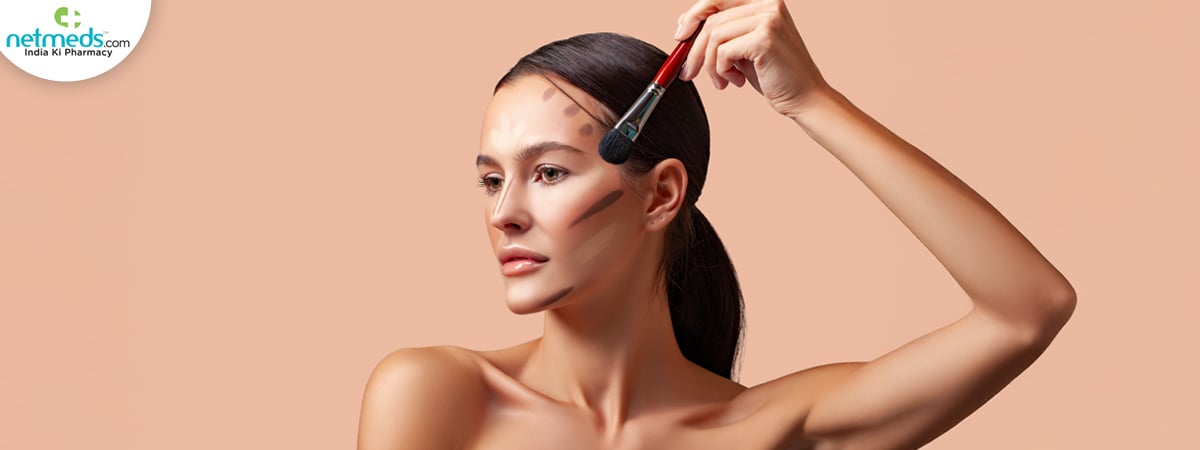Cheekbones that POP and a jawline that SLAYS? You have reached the right destination.
Contouring may seem intimidating (or something makeup artists only do), but let me tell you, once you get the hang of it, it is a breeze. So, whether you are preparing to take a selfie, a night out on the town, or simply need to perk up your own features, this tutorial guides you through learning how to contour like a pro, step by step. No stress, no crazy equipment needed. Just two or three products, blending, and a bit of beauty magic.
Ever googled ‘how to contour face step by step?’ This step-by-step guide will demonstrate how it is done for real, pro-approved tips. So, dig out your contour kit and let's get sculpting!

Also Read: 10 Easy Steps To Achieve A Natural And Flawless ‘No-Makeup’ Beauty Look
What Is Contouring?
Contouring is one of the most popular contouring makeup techniques that uses darker and lighter shades to make your features look more defined and deeper. It also enhances your facial structure and defines features like your cheekbones, nose, jawline, and forehead.
Think of it as sculpting your face using makeup, a resourceful way to show off your best features and add depth to your face without surgery or filters.
Also Read: Bought A Darker Shade Foundation? 7 Quick Fixes To Lighten And Match Your Skin Tone
From getting ready for your base to perfecting the highlight and contour trick, this easy tutorial guides you through all you would like to know to get that sculpted, lit look.

Step-by-Step Contouring Guide for Beginners
Step 1. Start with a Flawless Base
You should prep your canvas (i.e., your face) before contouring. Apply your regular skincare, a primer, and then even out your skin color with a foundation that matches your shade. This foundation is the base that all else is built upon and will let the rest of your makeup apply easily and prevent your contour from appearing uneven and mottled.
Step 2. Select the Ideal Contour Product
Select between cream, powder, or stick products based on the type of skin you have and your level of experience. If you are new to make-up, look for the best contouring products for beginners and these are usually something that is blendable, forgiving, and easy to use. You have products like creams, powders, and sticks and the best one for you is based on your skin type and familiarity.
Creams/Sticks: Ideal for dry skin or a natural, dewy finish.
Powders: Ideal for oily skin or to blend fast.
Pro Tip: Pick a 2-3 tone darker color than your skin to contour with, and a 1-2 tone lighter one for highlighting.
Step 3. Know Your Face Shape
Knowing your face shape is what allows you to contour correctly. These contouring tips for different face shapes will have you highlighting the right features:
Round face: Contour temples, under cheekbones, and jawline.
Oval face: Light contour underneath cheekbones and along sides of the forehead.
Square face: Soften jaw and contour forehead sides.
Heart face: Contour the temples and the end of the chin to balance width and length.
Step 4. Apply Contour Strategically
Use small brush or beauty sponge to apply contour on the following areas:
Cheekbones: Start at your ear and move towards your mouth, mid-cheek stop point.
Jawline: Contour by setting under your jaw and merging downward.
Nose: Narrow the bridge by drawing two parallel lines and blending.
Forehead: Contour along your hairline to give depth and warmth.
Step 5. Add Highlights for Contrast
Highlighting provides light to the parts of your face in which light would naturally hit, balancing out your contour and lighting. Use a light concealer, cream, or liquid highlighter on the middle of your forehead, nose bridge, under your eyes, chin, and cupid's bow. These areas lift your features and provide a beam of light. Blend thoroughly with your fingers or a sponge to make a smooth transition with your contour. This adds depth, contrast, and sculpted finish to your appearance.
Step 6. Blend Like Your Life Depends on It
This is where magic happens. Curious about how to mix contour makeups like a pro? Use a wet beauty sponge for creams or a blending brush for powders, and blend always in circular or tapping motions for a silky finish.
Pro Tip: Blend in small circular or dabbing motions in order to avoid harsh lines. Blending seamlessly is the key to a natural contour.
Step 7. Apply It
Lock your look with a transparent setting powder, particularly if you have used cream-based products. Give your highlighted areas a glow with a powder highlighter.

Bonus Tips for a Flawless Contour
Use contour products a little bit at a time, as little as possible.
Always contour in natural light to give you better accuracy.
Use matte formulas to create more natural shadows.
Keep practicing because your contouring skills improve with practice.
Conclusion
Contouring does not necessarily have to be all about being the full glam. You can do it lightly for day use or big time for nights out. Mastering the technique, you realize that it is like having a secret level in your beauty game. So go ahead, play around, blend nice, and let confidence hit new heights. This easy contouring guide de-mystifies how to master the art of sculpting your face in a step-by-step guide, even if you're a total newbie.
Feeling a contouring game glow-up? Try these steps out and let us know how it turned out for you in the comments!
Frequently Asked Questions
Why do we contour in makeup?
Contouring serves to add definition and enhance your natural features using shadows and highlights.
Can a beginner contour their face?
Yes, anyone can master contouring with the proper tools and technique.
Before or after foundation, should contouring be applied?
Always contour after your foundation for a flawless finish.
What is the difference between bronzer and contour?
Contour defines and creates shadows, whereas bronzer brings warmth and sun-kissed glow.
Is cream or powder best for contouring?
Powders are suitable for beginners and oily skin types, and creams provide a natural, blendable finish for dry skin.
(This article is reviewed by Kalyani Krishna Chief Content Editor)
Author Profile
Soumita Basu:
Soumita Basu holds a Bachelor’s Degree in Pharmacy and is keenly interested in Ayurveda, home remedies, yoga, fitness, diagnostics, and beauty. With nearly 6 years of experience, she produces evidence-based health content, including articles, videos, and infographics, to provide valuable insights to her audience.



 Previous
Previous